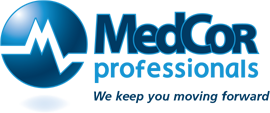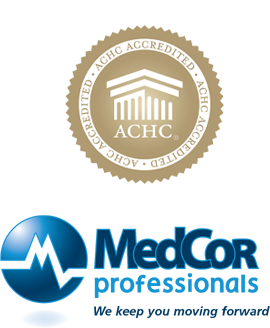Neck pain is a major cause of discomfort affecting many people at home and at work every day. It can range from a mild ache or “twinge” to extreme pain with weakness, tingling, and numbness in the arms. Minor cases might respond well to gentle stretching, heat, ice, and over the counter (OTC) pain relievers. Severe cases may not respond to a conservative approach and occasionally require surgery so it’s important to visit your trusted healthcare provider to find the source of your pain.
What’s causing my pain?
The root cause of neck pain varies but often stems from the following:
- Muscle strain due to overuse and poor posture from things like spending time hunched at a computer, smart phone, or behind the wheel of your vehicle.
- Arthritic or degenerative changes in the joints of your neck
- Disc compression and bulging discs that put painful pressure on nerves
- Injuries from auto accidents, sports, or a fall
- Diseases such as rheumatoid arthritis, meningitis, or cancer
Regardless of the cause, neck pain can have a detrimental impact on your physical, social, and psychological well-being.
What are my treatment options?
Whether it’s a result of “tech-neck” posture, an injury, a work-related strain, or from simply waking up with pain after sleeping in an awkward position, it's always a good idea to seek input from your preferred medical professional. A physical or occupational therapist, chiropractor, or physician will help define the root cause by doing some basic tests and then setting up a plan of care to address the underlying cause and symptoms. In some cases, x-rays or an MRI may be required to determine if surgery is required.
Usually, a conservative approach is warranted and surgery isn’t necessary! In these cases, your provider may recommend stretching, flexibility exercises, and strength activities. They may also recommend cervical traction to provide you some relief in the clinic and even at home.
What is Cervical Traction?
Cervical traction is the act of gently pulling up on the head to open the joints and relax the muscles in the neck. This provides relief for compressed or irritated nerves. It can be done manually by your provider who uses their hands to apply the pull or with a mechanical traction device. For best results, providers often recommend that traction be done multiple times a day if possible. With a device like the Saunders Cervical Traction unit, users can continue their traction therapy at home.
The Saunders Cervical Traction device has been providing safe, effective relief of neck pain for many years. It can be used by nearly anyone but having support from a medical expert or healthcare provider is suggested for first time users. Anyone who has extreme pain, reports of dizziness, or limitations in function should seek a thorough examination before using traction. For those who have been seen by a provider or had traction prescribed there are some important steps to follow for maximal results.
How do I use traction unit?
You should set up in a quiet area free of distractions where you can have 15-20 mins of uninterrupted time for the treatment. It is important that you use this time to relax so the device can provide the best results. Be sure to position the device on a firm but comfortable surface like a carpeted floor. Avoid using a bed or couch as they are too soft and would allow the device to shift while in use. It can be helpful to have a timer nearby as well.
The device has a forehead strap, neck wedges with adjustment dial and a handheld pump. You will lie down on your back and rest your head on the device between the neck wedges. You should secure the strap over your forehead and tighten the neck wedges with the dial until they provide firm but comfortable grip on your neck just below your ears.
For best results, once you lie down, take 3-5 mins to simply lie there and relax as you breathe deeply and slowly. This is important to get your muscles to relax and to take tension off nerves. After a few mins of this mindful relaxation, you’ll then begin the traction treatment.
Next, you will use the pump to apply the recommended amount of pressure. As you do, you’ll feel the neck wedges gently pulling your head. Continue pumping until the gauge shows the suggested pounds of force. Then turn the pressure gauge dial to “Hold” and set your timer for the recommended treatment time, often 15-20 minutes. You should feel a gentle pull on your neck with most people reporting symptom improvement immediately.
Once the treatment time is up, very slowly move the dial on the gauge to “Release”. You’ll feel the pressure slowly drop and the device will lower itself. At this point you can release the forehead strap before slowly and carefully moving into a sitting position. Once you are sitting up, take a minute to be sure you don’t feel dizzy or lightheaded feeling before standing up.
Detailed instructions on how to use the device use can be found in this video.
Most people find relief by using their traction unit at least daily for 15-20 mins but for the best results, many experts recommend using traction 2-4x per day for 15-20 minutes each. As mentioned previously, traction should be accompanied by flexibility and strengthening activities to support improved posture for lasting results. While 2-4x/day may seem challenging to make time for, many consider it a worthwhile investment in time and money as the Saunders Cervical Home Traction device is a great option that has been relieving pain for over 25yrs!
For more information on pain relief and how to get a Saunders Cervical Traction unit be sure to click here to contact us or stop by our store!
More info on Neck Pain in general
https://www.mayoclinic.org/diseases-conditions/neck-pain/symptoms-causes/syc-20375581
Great video on when and how to use the Saunders unit
https://www.youtube.com/watch?v=bKaV1QehHmA
Contributed by:
Chris Krause, OT/L
Dir. of Operations and Business Development – MedCOR Professionals, Scarborough, Maine

